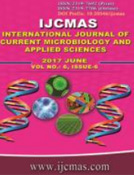


 National Academy of Agricultural Sciences (NAAS)
National Academy of Agricultural Sciences (NAAS)

|
PRINT ISSN : 2319-7692
Online ISSN : 2319-7706 Issues : 12 per year Publisher : Excellent Publishers Email : editorijcmas@gmail.com / submit@ijcmas.com Editor-in-chief: Dr.M.Prakash Index Copernicus ICV 2018: 95.39 NAAS RATING 2020: 5.38 |
A field experiment was conducted at IARI, Agronomy research farm, New Delhi during 2009-11 for two consecutive years to study the effect of sulphur nutrition on soybean- mustard cropping system (SMCS). The field trial was planned in split plot design to evaluate the residual effect as main plot representing combination of sulphur levels (0, 15, 30 and 45 kg/ha) and timing of sulphur application (100% at basal, 100% at flowering and split application as 50% basal + 50% at flowering) applied to preceding soybean crop and direct effect of S levels (0, 20 and 40kg/ha) applied as a basal to mustard crop as a sub-plot treatments. Residual effect of sulphur nutrition treatments applied to preceding soybean crop found non-significant on growth parameters, yield attributes and in quality parameters like oil content and oil yield of mustard. Where as in direct effect of Sulphur levels (0, 20 & 40 kg/ha) applied to mustard was found significant on growth parameters and yield attributes. The treatment with 40kg/ha has recorded significantly higher number of siliquae/plant (204.9), seeds/siliqua (14.47), test weight (5.73g), oil content (38.90%) and oil yield (711.07 kg/ha) of mustard seed compared to control and 20 kg/ha sulphur application. This study has demonstrated the importance of sulphur nutrition management for improving yield of oilseed based cropping system.
 |
 |
 |
 |
 |